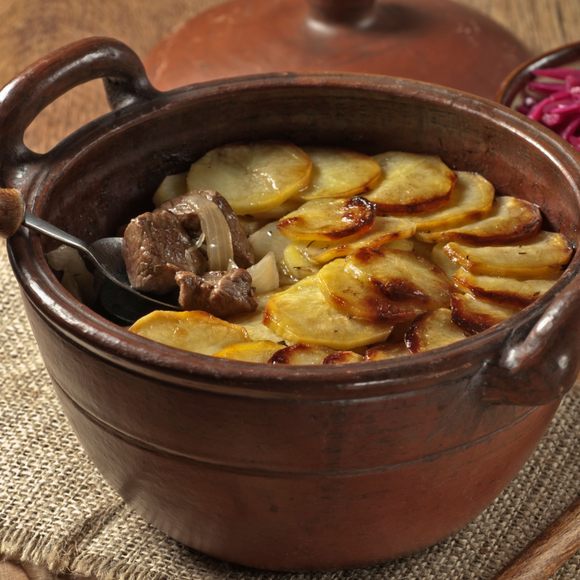Prepared Foods
Lancashire Hotpot
This “hodgepodge” of affordable ingredients fueled local laborers during the Industrial Revolution.
A classic winter pub favorite, the Lancashire hotpot is an unassuming delicacy of the North West of England. This hearty stew has a long history with Lancastrians, but after being published in The English Cookery Book in 1859, it became a hit with the rest of the country.
Some say the term hotpot refers to the tall, earthenware dish used to make the stew, while others say it’s derived from hodgepodge, a reference to the layers of ingredients. Closely related to a casserole, Lancashire hotpot traditionally consists of alternating layers of mutton (and sometimes sheep kidneys), root vegetables, and thinly sliced potatoes that get baked till golden brown.
During the Industrial Revolution, Lancashire became a powerhouse of the textile industry in northern England. While the industry boomed in wealth and success, many of the workers did not and lived in poverty. For cotton mill laborers, the hotpot was a filling, warming dish that a person could leave to cook while they worked. Its ingredients were also affordable and accessible. Root vegetables, for instance, were easy to grow in the gardens of the North West, as they required minimal tending. And while lamb-based hotpots were more often enjoyed by the wealthy, the working-class meat of choice was mutton. Derived from older sheep, it made for a cheaper alternative to lamb and is still used traditionally in home cooking and pubs.
The Lancashire hotpot’s humble ingredients combine into a hearty, aromatic meal. The aged mutton provides a much richer, stronger taste sensation than lamb, the root vegetables add earthy flavors and aromas, and the potatoes provide a warm, slightly crispy top layer. As a final touch, cooks often serve the meal with a side of pickled red cabbage.
Written By
 Madmerlined
Madmerlined
Sources
- archive.org/details/englishcookeryb00bookgoog/page/n8
- www.lancashire.gov.uk/lancashire-insight/economy/employment-surveys/sector-a-agriculture-forestry-and-fishing/
- www.bbcgoodfood.com/recipes/9099/lancashire-hotpot
- www.foodsofengland.co.uk/lancashirehotpot.htm
- www.pritikin.com/health-benefits-of-turnips
- county-wise.org.uk/counties/lancashire/
- www.deliaonline.com/recipes/international/european/british/traditional-lancashire-hotpot
- www.bbcgoodfood.com/recipes/1977640/red-cabbage-with-apples-and-star-anise
- www.edibleperspective.com/home/2015/4/3/quick-pickled-cabbage
- www.cooksinfo.com/lancashire-hotpot
- www.countryfile.com/go-outdoors/regional-food-lancashire-hotpot/
- www.telegraph.co.uk/expat/expatpicturegalleries/8451879/A-gastronomic-history-of-Britain.html?image=3
- munchies.vice.com/en_us/article/gvk3k9/how-margot-henderson-learned-to-love-plain-british-food
- books.google.com/books?id=_krN8uUKGbYC&pg=PA70&lpg=PA70&dq=%22lancashire+hot+pot%22+industrial+revolution&source=bl&ots=rDze-0LAB4&sig=ngFxqXkZMW7fo6HrWPuOpr_yuWc&hl=en&sa=X&ved=2ahUKEwjIle_Pm-HeAhXmUt8KHfV4CycQ6AEwCXoECAQQAQ#v=onepage&q=%22lancashire%20hot%20pot%22%20industrial%20revolution&f=false













